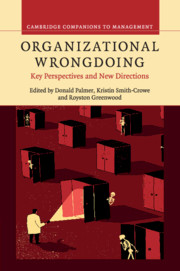Book contents
- Frontmatter
- Contents
- List of figures
- List of tables
- List of contributors
- Foreword
- 1 The imbalances and limitations of theory and research on organizational wrongdoing
- 2 On taking the theoretical substance of outcomes seriously: a meta-conversation
- 3 Wrong paths to right: defining morality with or without a clear red line
- 4 From market enablers to market participants: redefining organizational and political-legal arrangements and opportunities for financial wrongdoing,1930s–2000
- 5 Wrongdoing and market development: an examination of the distinct roles of trust and distrust
- 6 Bad apples, bad barrels and bad cellars: a “boundaries” perspective on professional misconduct
- 7 S/he blinded me with science: the sociology of scientific misconduct
- 8 Social networks and organizational wrongdoing in context
- 9 Falling stars: celebrity, infamy, and the fall from (and return to) grace
- 10 Compensation and employee misconduct: the inseparability of productive and counterproductive behavior in firms
- 11 Beware of organizational saints: how a moral self-concept may foster immoral behavior
- 12 “Is it me? Or is it me?” The role of coactivated multiple identities and identifications in promoting or discouraging workplace crimes
- 13 Consequences of organizational misconduct: too much and too little punishment
- 14 Who bears the brunt? A review and research agenda for the consequences of organizational wrongdoing for individuals
- 15 Organizational wrongdoing and media bias
- 16 Ethical learning: releasing the moral unicorn
- Index
- References
13 - Consequences of organizational misconduct: too much and too little punishment
Published online by Cambridge University Press: 05 July 2016
- Frontmatter
- Contents
- List of figures
- List of tables
- List of contributors
- Foreword
- 1 The imbalances and limitations of theory and research on organizational wrongdoing
- 2 On taking the theoretical substance of outcomes seriously: a meta-conversation
- 3 Wrong paths to right: defining morality with or without a clear red line
- 4 From market enablers to market participants: redefining organizational and political-legal arrangements and opportunities for financial wrongdoing,1930s–2000
- 5 Wrongdoing and market development: an examination of the distinct roles of trust and distrust
- 6 Bad apples, bad barrels and bad cellars: a “boundaries” perspective on professional misconduct
- 7 S/he blinded me with science: the sociology of scientific misconduct
- 8 Social networks and organizational wrongdoing in context
- 9 Falling stars: celebrity, infamy, and the fall from (and return to) grace
- 10 Compensation and employee misconduct: the inseparability of productive and counterproductive behavior in firms
- 11 Beware of organizational saints: how a moral self-concept may foster immoral behavior
- 12 “Is it me? Or is it me?” The role of coactivated multiple identities and identifications in promoting or discouraging workplace crimes
- 13 Consequences of organizational misconduct: too much and too little punishment
- 14 Who bears the brunt? A review and research agenda for the consequences of organizational wrongdoing for individuals
- 15 Organizational wrongdoing and media bias
- 16 Ethical learning: releasing the moral unicorn
- Index
- References
Summary
Misconduct, malfeasance, and corruption are all terms that describe behaviors that are against common norms and in many cases also illegal. Misconduct can be defined as “behavior in or by an organization that a social control agent judges to transgress a line separating right from wrong” (Greve, Palmer, and Pozner 2010: 56). The definition includes a social control agent, an actor with a mandate to label actions as misconduct and punish them. Accordingly, societal reactions against organizations that engage in misconduct are expected from the state and possibly also from other actors such as exchange partners, professional organizations, individual consumers, or workers. This expectation is so strong that one might wonder whether analysis of misconduct punishment is too obvious to even pursue. Are any surprises possible? In fact, research so far has uncovered a few surprises that suggest a strong need to examine the phenomenon further. First, the extent of punishment varies widely and includes cases of non-punishment. Second, the actors who do the punishment vary and include actors who should be indifferent as they are not harmed by the wrongdoing. Third, the range of organizations that get punished is broad and, as a result of stigmatization, includes organizations that did not engage in the original misconduct. Because punishment can be unrelated to misconduct, we often use the term “punished organization” rather than wrongdoer.
These surprises will remain just that – surprises – until we reach a richer understanding of the consequences of misconduct based on theory and evidence. We are some distance away from this goal, and so the aim of this chapter is not to provide answers, but instead to give a map of the task ahead and a description of the early evidence. For convenience, we divide the treatment into discussions of (1) why social control agents punish, (2) how social control agents punish, (3) who are punished by social control agents, and (4) how organizations react to punishments. These issues are interrelated but still best discussed separately. We focus on punishment by actors other than the state to avoid overlap with the criminal justice literature.
To understand the consequences of misconduct, four factors with obvious effects are the nature of the misconduct, the organization responsible for it, the actors observing and reacting to it, and the conditions of the environment of these actors.
- Type
- Chapter
- Information
- Organizational WrongdoingKey Perspectives and New Directions, pp. 370 - 403Publisher: Cambridge University PressPrint publication year: 2016
References
- 4
- Cited by

